Signators of the Declaration
A Dunham Tavern Story
Duncan Virostko, Museum Assistant
In the keeping room of Dunham Tavern, there hangs a facsimile of the signatories of the Declaration of Independence. Dating to 1855, it was created by engravers J W Allen, A H Wray, & E. McCabe and published in New York. It is based upon a much earlier and even more elaborate facsimile of the entire Declaration, produced in 1819 by publisher John Binns for a $10 subscription fee. The endorsement of the signatures authenticity, by John Quincy Adams, is notable as he was personally familiar with many of the founding fathers, being the son of John Adams.
Amongst the names of more familiar Founders, Ohioans will spot a name they have seen before: Huntington. Samuel Huntington was one of four representatives of Connecticut, later the president of Congress under the Articles of Confederation, and he would go on to play three important roles in the founding of Ohio. As the 18th Governor of Connecticut, from 1786-1796, he would oversee the settlement of the Western Reserve of Connecticut, a area now part of North East Ohio, as compensation for those who had lost their homes due to the British Army’s campaigns during the Revolutionary War. He was also a signatory of the Northwest Ordinance, a compact which ceded the land to the United States and what became the Ohio Territory, and also established laws which mandated public education and banned slavery in the new territories.
He and his wife Martha Devotion-Huntington were never able to conceive a child, but when his brother Rev. Joesph Huntington died they took in his young sons and with his raised them as their own. His own death in 1801 thus had a rather direct effect on Ohio history: Samuel H. Huntington, Jr., his son and nephew, would with wife Hanna move to Cleveland, Ohio, where he would act as both a land agent and tavern keeper. Subsequently, Samuel Huntington Jr. would become Ohio’s third governor, in 1808. Unfortunately, his term was marred by political controversy and ended in a failed run for U.S. Senate. Chronically ill and injured in an accident, he would die in 1817, survived by six children.
As seen here, the framed facsimile copy of the signatures of the Declaration of Independence hung for many years in Dunham Tavern’s taproom, seen here ca. 1972.
Also notable to Clevelanders might be the name “Charles Carroll of Carrollton”, who was one of Maryland’s representatives. The only Catholic to sign the Declaration, and the longest living signatory, he was signed his name in such an idiosyncratic way in order to distinguish himself from his father and several other Charles Carroll’s of the time. One of the richest men to sign, he indeed staked his “treasure, life, and sacred honor” to the Revolutionary cause. Long after the war, in 1827, he would also lay the first milestone of the Baltimore & Ohio Railroad, which would go on to become on the nations oldest railroads and eventually serve Cleveland. His cousin, John Carroll, meanwhile, was more concerned with spiritual callings, and would become the first archbishop of the United States. Both men were Jesuits, and the latter would of course become the namesake of John Carroll University.
Documents such as these remind us of the closeness of our earliest Ohio settlers to the American Revolution. Rufus Dunham, born in 1793, and his wife Jane Pratt Dunham, born in 1797, would have been part of the first generation to be born under the US. Constitution, which was written in September 1788 and adopted in 1789. Some veterans of the American Revolution would live until the 1860s, long enough to be photographed. Virtually every adult they would have know growing up would have directly experienced the oppression of British rule, the turmoil of the Revolution, and the instability which came after the war with Britain had ceased. It is no wonder then that they and their children held such people in great reverence. Thus, copies of the Declaration, Constitution, portraits of Washington, Jefferson, Madison, and all sort of patriotic items commonly adorned their homes.
We are apt to think that we live in especially perilous times, and often feel a deep pain when matters of state are fraught. It is heartening then to remember that we are not alone in such sentiments, and that in the first century of it’s existence the United States was quite fragile. A brief examination of the events Rufus Dunham lifetime illustrates this. In his early twenties, Rufus Dunham would have lived through the War of 1812, and experienced the invasion of American soil by a foreign power, and the burning of it’s capitol city. He would later in life see the nation in which he had lived his entire life, and grew up alongside, be torn asunder by Civil War. As he died in late 1862, he did not live to see the restoration of the Union… in fact at the time the Union Army had been suffering from a number of defeats. It would not be until July 3rd, 1863, at the Battle of Gettysburg, that the tide of war would finally turn against the South. He took no direct part in any of these historical events, yet nonetheless he would have keenly felt their impact.
Yet for all the human failings of it’s leaders and citizens, and the flaws of it’s founding documents, the United States has managed to survive, grow, and improve itself. Although the work set out for us in 1776 is far from complete, and eternal vigilance is the price of liberty, we can all take solace and perhaps find hope in the fact that time and again we have faced and overcome great challenges.
Sources:
https://digital.librarycompany.org/islandora/object/digitool%3A128653
https://en.wikipedia.org/wiki/Samuel_Huntington_(Connecticut_politician)
https://en.wikipedia.org/wiki/Samuel_Huntington_(Ohio_politician)
https://case.edu/ech/articles/h/huntington-samuel-jr
https://en.wikipedia.org/wiki/Charles_Carroll_of_Carrollton



